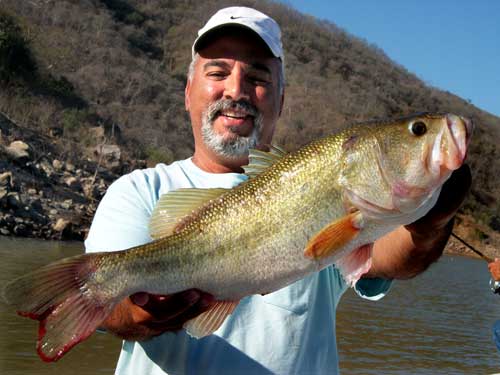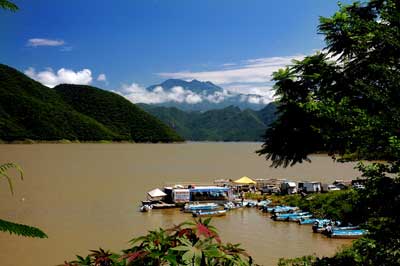|
By John Pint
 Aguamilpa
is one huge lake. It covers 128 square kilometers and was
created by creating yet another dam on the ubiquitous Santiago
River. If you look for it on the internet, you will easily find
25,000 sites assuring you that Aguamilpa is the place to
go to catch big, beautiful, tasty bass. Aguamilpa
is one huge lake. It covers 128 square kilometers and was
created by creating yet another dam on the ubiquitous Santiago
River. If you look for it on the internet, you will easily find
25,000 sites assuring you that Aguamilpa is the place to
go to catch big, beautiful, tasty bass.
U.S. fishermen are particularly gaga about this lake. According
to Steve Quin of In-Fisherman Magazine, “The lake record for two
fishermen in one boat in one day stands at 628 bass!” He also
mentions that the largest one caught in the lake so far weighed
around twelve pounds and he notes that there are over 330 miles
of bass-fishing shoreline at Aguamilpa.
Legendary bass fisherman “Wild Bill” Skinner—supposedly the
first person to check out the bass fishing at this dam during a
trial period in 1995, says, “Lake Aguamilpa is considered by
many as one of the hottest bass lakes in the world. You can
catch them in the 3-12 pound range with numbers at times
exceeding 100 bass a day per fisherman.”
What these experts are talking about, of course, is
“catch-and-release” fishing, as the law only allows you to go
home with a maximum of two per day. That regulation might make
some potential visitors ask, “OK, what else can you do at
Aguamilpa?”
Two of my friends asked that very question and discovered that
there are several Huichol villages along the shore where
visitors can shop for locally made crafts, enjoy a delicious
fish dinner overlooking the lake and even stay overnight in a
Huichol hotel. Says Tom Marshall:
“The village is inaccessible by car, bringing with it a peace
and quiet that you rarely find these days. The people are
extremely warm in welcoming visitors and a range of activities,
from horse-riding to boat rides on the river, are on offer. It
was an experience I would definitely recommend and one that
gives you a much greater understanding of Huichol culture and
the challenges they face.”
The drive to Aguamilpa Dam is scenic and particularly pleasant.
You could call the toll road from Guadalajara to Tepic “The
Basaltic Beltway” because it takes you right past some of the
major volcanoes of western Mexico. First you come to Tequila
Volcano with its easily recognized Plug or tetilla at the
top, then you skirt Ceboruco Volcano, whose crater still sports
plenty of hissing fumaroles. As you pass through this area, note
the great barren stretches of broken-down black basalt on both
sides of the highway. Upon approaching the edge of Tepic, the
huge, hulking silhouette of Sanganguey Volcano looms above you
on the right. This lets you know it’s time to watch for a
bizarre monument indicating the turnoff to Aguamilpa (which may
not be mentioned on any signs). This landmark is a work of
modern art topped by a tall, skinny, green arch maybe seven
meters high. Here you turn right onto a well-paved highway
heading for the dam. You’ll know you’re on the right road if you
notice a train track paralleling the highway.
 Now
comes a one-hour drive through mango orchards and scenic hills
dotted with a number of intriguing rocky spires. After you spot
Lake Aguamilpa in the distance, keep your eyes open for a Y in
the road. The left fork leads to the area below the dam, but you
want the right fork, which goes to La Cortina (the dam), the
town and the waterfront where you’ll find boats for rent and
Cora’s Lodge, a delightful place to spend the night with a
dramatic view of the lake. The owner, Mario “Big Fish” Guevara,
can arrange as much bass fishing as you like, as well as a visit
to one of the Huichol villages. You might even want to take a
boat ride up one of the rivers, where it is said you can
actually see crocodiles. Now
comes a one-hour drive through mango orchards and scenic hills
dotted with a number of intriguing rocky spires. After you spot
Lake Aguamilpa in the distance, keep your eyes open for a Y in
the road. The left fork leads to the area below the dam, but you
want the right fork, which goes to La Cortina (the dam), the
town and the waterfront where you’ll find boats for rent and
Cora’s Lodge, a delightful place to spend the night with a
dramatic view of the lake. The owner, Mario “Big Fish” Guevara,
can arrange as much bass fishing as you like, as well as a visit
to one of the Huichol villages. You might even want to take a
boat ride up one of the rivers, where it is said you can
actually see crocodiles.
Guevara told me that the options mentioned on his
Cora's Lodge web site
are geared for U.S. fishermen who may come down to Aguamilpa for
five days or more. People living in Mexico, he says, might
typically pay 2000 pesos plus tips for a night at Cora’s Lodge
plus meals and a day of fishing or sightseeing. “Contact me (coraslodge
@ hotmail.com; TEL 045 323 101-0728) for various options,” he
recommends, “and don’t forget our summer special: 20 percent off
from Monday to Thursday.” If you don’t have fishing gear, Mario
will rent it to you.
If you’d like to be a fisherman-for-a-day, just to have that
experience, this might be your golden opportunity. You get all
the fun of fishing with none of the waiting!
How to get there
Take Mexico Highway 15 northwest to Tepic. At the edge of the
city, look (on the right side of the road) for the tall, green
“artsy arch” mentioned above (and shown in the sideboard) and
turn right. You’ll now be on a well-paved road heading north,
past the towns of Francisco Madero and Mesas de Picachos, to
Aguamilpa. Remember to bear right at the Y to get to the wharf
and the town. Driving time from Guadalajara is about three and a
half hours and at least an hour more if you’re starting out from
Chapala.
|

